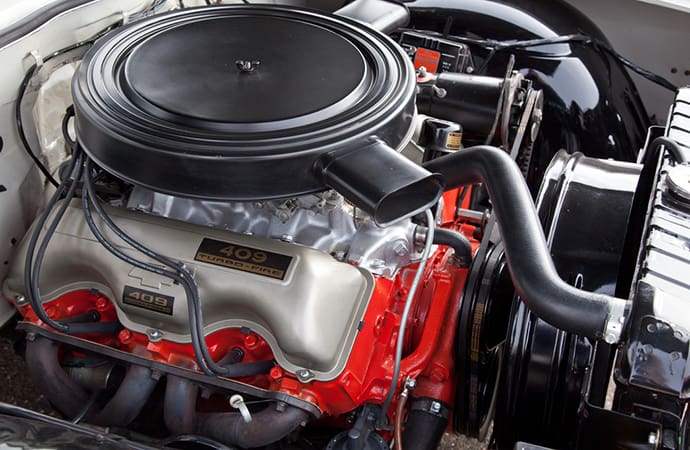Editor’s note: This is part two of a five-part series looking at the history and future of the muscle car. Read the whole series during July, when the ClassicCars.com Journal celebrates all things muscle.
Although Chevrolet had a V8 in vehicles way back in 1917 and 1918, it abandoned that architecture, and even skipped the straight-8 setup used by other General Motors divisions. It wasn’t until the 1955 model year that Chevrolet launched its own V8, called the Turbo-Fire engine.
At first, that engine displaced 265 cubic inches and powered the Bel Air sedan (with 162 horsepower) and the Corvette roadster (with 195 hp). But through the years, the engine would prove to be transformational among automotive powerplants and would emerge as the basis for Chevrolet (and GM) V8s for decades to come.
It worked for hot rodders as well. Look into the engine bay of many hot rods and custom cars for various brands and you’re liable to see a tried-and-true small-block Chevy V8.
Once it got into the V8 business, Chevrolet realized it needed even more power, primarily for trucks but also for larger passenger cars, so for the 1959 model year, it rolled out a big-block V8. The first version displaced 348cid, but for 1961 displacement grew to 409, and in 1962 to 427.
Even if you care nothing about cars, that 409 figure should ring a bell because it not only ignited a second round of muscular machines from Detroit, but a popular hit song by The Beach Boys:
“Well, I saved my pennies and I saved my dimes
(Giddyup, giddyup, 4-0-9)
For I knew there would be a time
(Giddyup, giddyup, 4-0-9)
When I would buy a brand new 4-0-9.”
Chevrolet’s full-size sedan, the Impala, could be equipped with the 409 engine, and with a dealer-installed Super Sport trim package that included SS emblems, power brakes and steering, heavy-duty springs and shocks, a 7,000-rpm tachometer and narrow-band white-sidewall tires and special wheel covers.
The 409 engine provided 360 horsepower, enough to power the Impala 60 mph in less than 7 seconds and down the quarter mile in 15.8. Stuffed into a lighter Bel Air coupe, the 409 won the national Top Stock Eliminator drag-racing championship.

The early-to-mid 1960s were the era of factory-backed, production-based stock-car and drag-racing programs, the latter part of the Super Stock or A/FX (Factory eXperimental) category.
Ford, in its Total Performance heyday, produced lightweight Galaxies with 406cid V8s and later, lightweight Fairlane Thunderbolts powered by 427cid engines for drag racing. There also were tricked-out Mercury Comets.
Pontiac had its Catalina Super Duty with a 421cid V8 pumping out more than 400 horsepower. There was a Plymouth Sport Fury with a big Hemi V8 for the street, and Dodge had the Coronet A990 and Plymouth, its much-altered Belvedere with a 426 Hemi V8 for drag racing.
As more and more modifications were made to the production-based cars, a new professional racing category — purpose-built Funny Cars, basically Top Fuel racers disguised with fiberglass stock-style bodies — would emerge.
And before too long, Detroit would turn its attention from the track and strip to putting more power on the street.
Read the other parts of the series:
- • Part I: The road to the muscle car was paved after World War II
- • Part II: Better late than never: How Chevrolet changed V8 engines
- • Part III: How the Pontiac GTO initiated the heyday of muscle cars in America
- • Part IV: Buick led a short-lived muscle car renaissance in the ’70s and ’80s
- • Part V: Will the muscle car go extinct or flourish in a changing world?






The 348 came out in 1958. I know, I had this dog. I really wished that car had had the 283.
Actually I was surprised that the article was about the big blocks. Chevy indeed changed the V8 landscape and still does with the small block. 348/409 truck engines… Eh, just a blip in history. It was a catchy song though.
Fellow called "engine Charlie" developed the V8 for GM. He went on to become the Secretary of state under Eisenhower. Charles , CE, Wilson
The mouse, or the rat?
Whenever you hear a tv commentary they always comment on the GTO as the start of the muscle era, have they never heard of the 409’s, 418’s etc, long before the Goat.
The Super Sport option was not dealer installed. The cars were purpose-built in the factory.
IN THE 60s FRIEND OF MINE R. WALSH (GOOSE) OWNED A 1940 FORD COUPE 283CI CHEVY ENGINE DUAL MALLORY IGNITION POINTS- 3/4 RACE CAM- SOLID LIFTERS- ELECTRIC FUEL PUMP- 3 SPEED HURST- 456 P/U TRUCK POSI REAR. GOOSE TAUGHT ME TUNE UPS ADJUSTING GAP AT ROCKERS REBUILDING 3 SPEEDS.GOOD LOOKING MIDNIGHT BLUE REMOVABLE HOOD BRUSHED ALUMINUM FIRE WALL RED 283 WITH CHROME IT WAS A GOOD TIME IN MY TEENS JOE
In the early 60’s I bet I heard “3/4 Race Cam” daily, today you rarely hear the term from someone that does not have grey in their hair. In the Chevy tri-fives, there were so many with a hole in the grill I thought it might have been a dealer option. 😀 (the purpose was to change the cam without pulling the motor). I never saw or heard about a “Full Race Cam”. Thanks for bringing back memories of the “serious” discusions about hot cars. No one was more knowledgeable about fast cars than 13 year old boys.